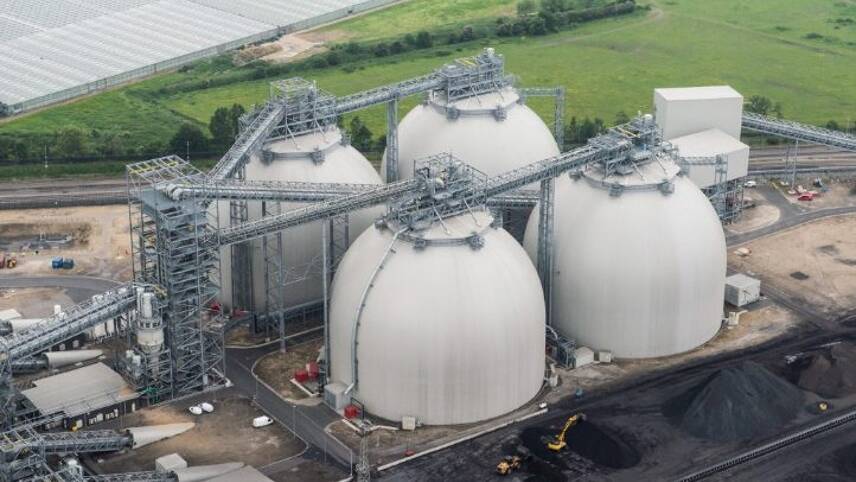Register for free and continue reading
Join our growing army of changemakers and get unlimited access to our premium content

Biomass domes at Drax Power Station. Image: Drax
The company claims the trial of bioenergy with carbon capture and storage (BECCS) is the first of its kind anywhere around the globe and could eventually enable Drax to become the world’s first “negative emissions” power station.
“Proving that this innovative carbon capture technology works is an exciting development and another important milestone in our BECCS project,” Drax Group’s chief executive Will Gardiner said.
“Climate change affects us all so this is of real significance – not just for us at Drax, but also for the UK and the rest of the world.
“The successful deployment of BECCS requires us to identify ways in which the carbon dioxide we’re now capturing can be stored or used in other processes and we’re working with the government and other businesses on that.”
Energy and clean growth minister Claire Perry added: “This innovative technology has the potential to make huge strides in our efforts to tackle climate change while kick-starting an entirely new cutting-edge industry in the UK.
“World-firsts like this will help us to realise our ambition of having a first operational plant by the mid-2020s as we continue to seize the opportunities of moving to a greener, cleaner economy – a key part of our modern industrial strategy.”
The £400,000 pilot project is being undertaken in partnership with C-Capture which installed and commissioned a demonstration carbon capture and storage unit at the power station in November. Its propriety solvent is being used to isolate carbon dioxide from the flue gases released when biomass is burnt to generate electricity.
Chris Rayner, the company’s founder and professor of organic chemistry at the University of Leeds, said: “This represents a major milestone on the road to achieving negative emissions through BECCS, which is going to be so important in the future.
“To see our technology working in a real environment like Drax is a tribute to the fantastic team of chemists and engineers who work on the project.”
C-Capture’s director of engineering Caspar Shoolderman added: “Working at this scale is really where the engineering gets interesting.
“The challenge now is to get all the information we need to design and build a capture plant 10,000 times bigger. It’s only really when we get to those sorts of scales that we can start to have an impact on the climate.”
Drax, BP and IP Group recently agreed to invest £3.5 million in C-Capture.
Tom Grimwood
This article appeared first on edie’s sister title, Utility Week


Seriously? Drax to be the first negative emission power station? Do you really expect us to believe that garbage?
Firstly factor in the oil used to cut down the trees, then the power used to process the wood into pellets then add in the fuel oil used to transport the pellets thousands of miles across the sea, now add in the fuel used to transport the pellets to Drax to be burnt. Finally add in the power used by this BECCS unit. OK so how much Carbon Dioxide will Drax have to remove to be negative emissions?
Now I am not saying the technology itself is bad, far from it. If it works then it may well help but until the true energy cost of Biomass is taken into account there is no way it can ever be called "green".
Quite so, Kieron. Drax already receiving large subsidies, paid for by all in heir electricity bills, just how much this "new" process will cost is anybody’s guess.
The process does not seem to fundamentally different to those already attempted, without economic success. The difference lies in the adsorber. The scale of plant to be constructed, running costs in plant operation and final disposal costs cannot be radically different from fore-runners.
The CEO of Drax, Will Gardiner, is quoted as exalting the technology, but hardly an engineer or scientist. In LinkedIn his graduate qualifications are quoted as International Relations and Economics, and Soviet Studies. Excellent in their field, no doubt whatsoever; but involving not too much thermodynamics.
And should we be felling whole forest areas in the USA just to feed out power stations? Wood is a poor fuel for this purpose, mainly a carbohydrate, cellulose, half of its weight is water, chemically combined. This is boiled off by the combustion of the carbon, the steam produced is heated to about 190oC, and blown up the chimney! Our domestic gas "boilers", have to recover this heat, condensing boilers; not Drax, we pay them to do it.
Oh dear!
Richard Phillips